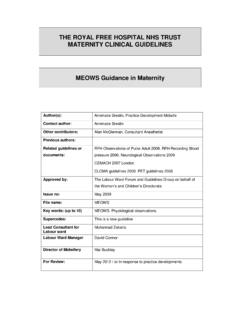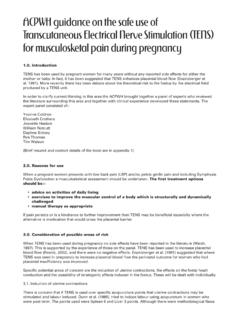Transcription of Total and High Spinal Anaesthesia
1 MAT0054/ Total and High Spinal /Version 3/April 2017 Page 1 of 8 Document Ref: MAT 0054 WOMEN AND CHILDREN S and CLINICAL SUPPORT SERVICES DIVISION Clinical Guideline For use in: (Clinical Area) Maternity Department For use by: (Staff Group) Doctors and Midwives Distributed to: Staff in the Maternity Department Author/s: Jane Hermanowski, Specialty Registrar, Anaesthetics Aditi Modi, Consultant, Anaesthetics Other contributors: Deborah Meldrum, Consultant, Anaesthetics Clive Duke, Consultant, Anaesthetics Date of issue: April 2017 Date of review / by: April 2020 Status: APPROVED Equality impact assessment (HO 2010) April 2017 Approved by: Malini Prasad Lead Consultant Obstetrician PP. Jac Reeve Approved by: Aditi Modi Lead Consultant Anaesthetist Aditi Modi Approved by: Lynne Saunders. Acting Head of Midwifery Lynne Saunders High Regional block (including Total Spinal Anaesthesia ) MAT0054/ Total and High Spinal /Version 3/April 2017 Page 2 of 8 INDEX MAT0054 High Regional block (including Total Spinal Anaesthesia ) April 2017 Section Title Page Number 1.
2 Introduction 3 2. Timing of High Regional block 3 3. Prevention of High Regional block : Good Practice 4 4. Identification of High Regional block 4 5. Management of High Regional block 5 6. Postnatal Management 6 7. References 6 8. Associated Documents 6 9. Monitoring/Audit Standards 7 Appendix 1 Algorithm: Management of a High Regional block in Obstetrics 8 PREVIOUS DOCUMENT First issued Reference No Present version number Reference: MAT0054 Version No 3 Supersedes Changes compared to previous document Definitions of high regional block and Total Spinal are included, with emphasis on their shared aetiology and the possibility of a high regional block becoming a Total Spinal . Clinical features listed by their relevant Spinal level, to enable estimation of block height and likely progression. Postnatal management expanded to prompt the use of team debriefing and thorough documentation Updated flow diagram (Appendix 1) now clearer to follow Updated references Statement of clinical evidence There is currently no national guideline for the management of high regional block or Total Spinal Anaesthesia .
3 The Obstetric Anaesthetists Association (OAA) have collected good examples of local guidelines for the management of high regional block from around the country. This updated guideline is based upon sample guidelines published on the OAA s website and is supplemented by evidence from the literature (including national studies) as well as incorporating local procedures ( use of the Maternal Collapse emergency call). MAT0054/ Total and High Spinal /Version 3/April 2017 Page 3 of 8 High Regional block (including Total Spinal Anaesthesia ) 1. INTRODUCTION The occurrence of a high regional block or Total Spinal can be potentially catastrophic for both mother and baby, and require immediate management. They may occur following Spinal or epidural Anaesthesia and therefore can occur outside of the operating theatre. Both are due to the inappropriately high spread of local anaesthetic affecting Spinal nerves and as such are on a continuum of severity: High Spinal /regional block : spread of local anaesthetic affecting the Spinal nerves above T4.
4 The effects are of variable severity depending upon the maximum level that is involved, but can include cardiovascular and/or respiratory compromise. Total Spinal : intracranial spread of local anaesthetic resulting in loss of consciousness. A Total Spinal can also occur following epidural Anaesthesia /analgesia. As the above are different severities of the same process, they may both be referred to as high regional block . Left untreated, a high regional block can progress to a Total Spinal . The reported incidence of high regional block varies greatly in the literature (partly due to the overlap between the features of high and Total spinals); from an incidence of 1:100 (1%) for high spinals to a risk of <1:100,000 ( ) for Total spinals (the OAA patient information leaflet states a risk of 1:100,000 for unconsciousness from an epidural). Rapid recognition and management is necessary to ensure an optimal outcome for the mother and fetus.
5 2. TIMING OF HIGH REGIONAL block This can occur at any of the following times: During labour in a mother with an epidural: following unrecognised dural puncture by either the Tuohy needle or epidural catheter itself: o Following a test dose, or o Following a top up (via pump or manual top up by anaesthetist) In theatre: o Following epidural top up or Spinal Anaesthesia o Following a Spinal anaesthetic in the presence of an existing epidural block (this increases the risk of a high block from a standard Spinal anaesthetic dose) Post-operatively: o A high block can have a later onset so it is important to remain alert to the possibility, especially as attention will be diverted elsewhere after delivery of the baby MAT0054/ Total and High Spinal /Version 3/April 2017 Page 4 of 8 3. PREVENTION OF HIGH REGIONAL block : GOOD PRACTICE Epidural analgesia/ Anaesthesia : Use low concentrations of local Anaesthesia for labour analgesia Prior to top up: o Assess block (to guide top up dosage) o Aspirate the epidural catheter with a 2ml syringe to rule out intrathecal or intravenous placement Consider giving large volumes of local anaesthetic in divided doses (clinical urgency may preclude this) Spinal Anaesthesia : Consider the level [and therefore local anaesthetic dose] required for surgery (LSCS vs.)
6 Manual removal of placenta) Patient position: block height can be manipulated for up to 30mins when using hyperbaric ( heavy ) anaesthetics if using head down position to establish block , remember to remove it as soon an possible Patient characteristics: consider dose reduction in short or morbidly obese patients Technique: o Consider effects of speed of injection o Avoid excessive barbotage If performing a Spinal following an epidural, a dose reduction may be necessary depending on the existing level of block (reductions to of local anaesthetic have been suggested following a failed epidural top up); there is no clear consensus on this. For epidural and Spinal Anaesthesia : Don t inject during a contraction/cough/Valsalva as this can increase cephaled spread of local anaesthetic The use of the Oxford wedge is recommended to prevent cephaled spread of local anaesthetic (and to optimise airway positioning in the event of requiring general Anaesthesia ) 4.
7 IDENTIFICATION OF HIGH REGIONAL block The clinical features are dependent on the level of the Spinal nerves affected by the local anaesthetic. Untreated the block may ascend further leading to more severe features as shown below: Spinal level Area(s) affected Symptoms/signs T1-T4 Cardiac sympathetic fibres blocked Hypotension Bradycardia C6-C8 Hands and arms Paraesthesia or numbness in hands/arms Weakness of hands/arms MAT0054/ Total and High Spinal /Version 3/April 2017 Page 5 of 8 Shortness of breath (accessory respiratory muscles affected) C3-5 Diaphragm and shoulders Shoulder weakness respiratory compromise immenent Hypoventilation and/or desaturation Respiratory arrest Intracranial spread Brain stem Slurred speech Sedation Loss of consciousness 5. MANAGEMENT OF HIGH REGIONAL block The principles of assessment and management of a high regional block are shown below and summarized in the Appendix.
8 If a high regional block is suspected on CDS, call for urgent help using Maternity Code Red Whilst awaiting further help immediate management includes: Stop epidural pump if present Deliver high flow oxygen via facemask If possible, place the bed head up (reverse Trendelenburg) to prevent further upward spread of local anaesthetic. Otherwise, left lateral position or supine with manual uterine displacement. Reassure the mother and any relatives in the room Ask the MCA or another midwife to escort the relatives from the room Assess the patient: Following an ABCD approach If there is significant respiratory compromise or there is loss of consciousness and/or the airway, then there is MATERNAL COLLAPSE: Call 2222 and state maternal collapse if anaesthetist and obstetrician not already present Send for the resuscitation trolley and emergency anaesthetic drugs (drug fridge in CDS or in theatre 2 anaesthetic room) Alert ODP (840) and theatres The patient will require intubation and ventilation: o Rapid sequence induction (RSI) with cricoid pressure and suction available o Induction agent (at a reduced dose) should still be used as awareness is still possible in an apparently unconscious patient.
9 O Suxamethonium or rocuronium as appropriate o Fluids and vasopressors should be ready to use o Remember that in the event of a failed intubation in this situation spontaneous ventilation is not expected to return. The failed intubation guidelines should be followed in this event. Sedation and ventilation will need to continue until the block wears off and spontaneous ventilation resumes this may take a few hours depending on the doses of local anaesthetic that were used Once mother is stabilised, assessment of the fetus is required delivery by LSCS may be required or it may be more appropriate to wait. If a LSCS is required then the MAT0054/ Total and High Spinal /Version 3/April 2017 Page 6 of 8 paediatric team will need to be called to attend (expecting an anaesthetised baby as interval from induction to delivery will be longer than routinely expected).
10 If there is circulatory compromise: Place the woman in left lateral tilt or provide manual uterine displacement Ensure patent large-bore IV access Treat bradycardia if present: o Glycopyrrolate 200-600mcg o Atropine 200-500mcg Treat hypotension: o IV fluid bolus o Vasopressors: phenylephrine, ephedrine, metaraminol boluses titrated to effect An IV infusion may be required Consider dilute adrenaline (10mcg/ml minimum dilution) if no response to above for only anaesthetist to do If following a structured ABCD assessment there is no compromise identified, then the woman needs to be closely monitored. Assessments from the anaesthetist and obstetrician are also required. The stabilisation of the mother is in the best interests of both her and the fetus, however once this has been achieved consideration of the plan for the fetus will need to be given.






